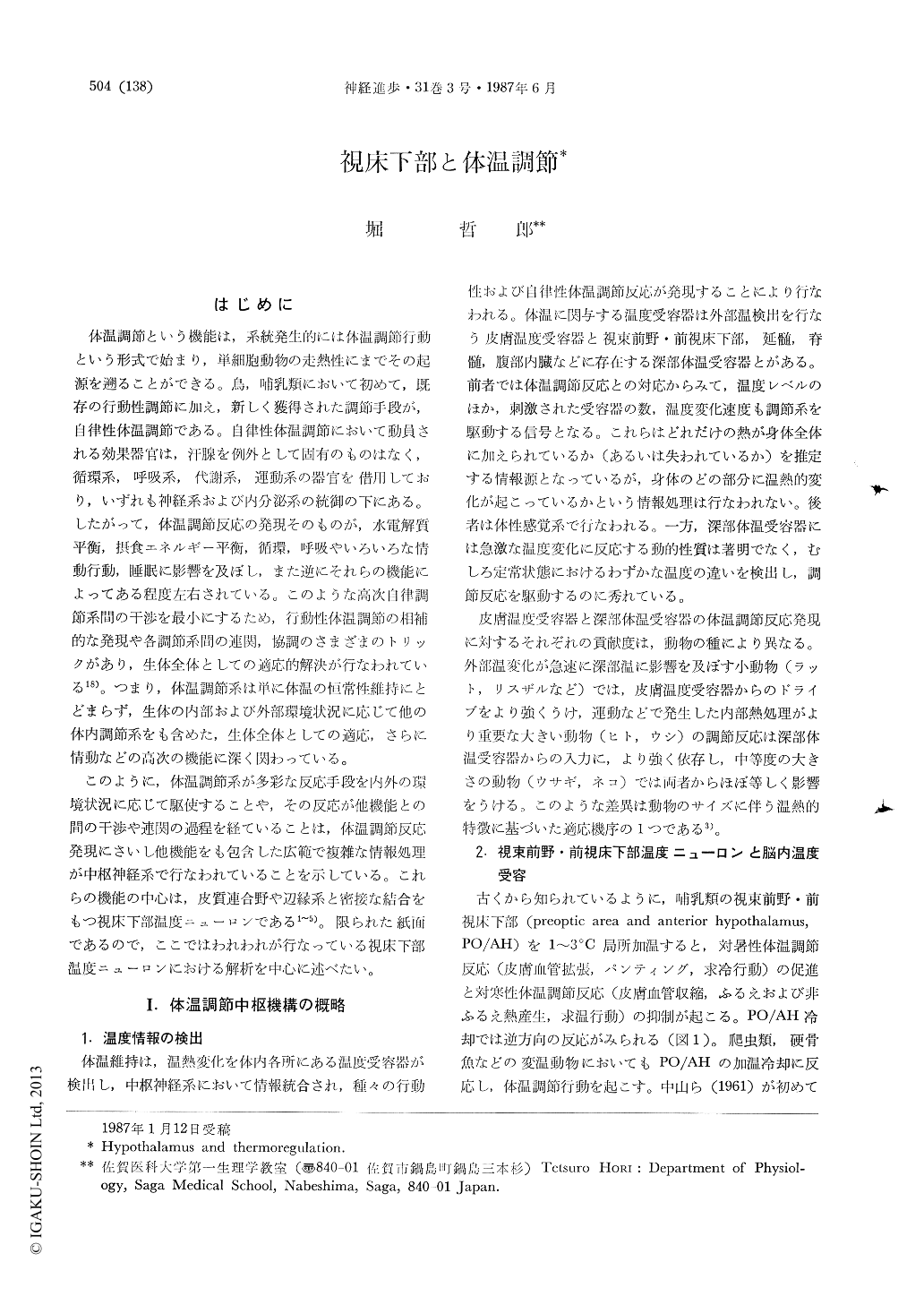Japanese
English
- 有料閲覧
- Abstract 文献概要
- 1ページ目 Look Inside
はじめに
体温調節という機能は,系統発生的には体温調節行動という形式で始まり,単細胞動物の走熱性にまでその起源を遡ることができる。鳥,哺乳類において初めて,既存の行動性調節に加え,新しく獲得された調節手段が,自律性体温調節である。自律性体温調節において動員される効果器官は,汗腺を例外として固有のものはなく,循環系,呼吸系,代謝系,運動系の器官を借用しており,いずれも神経系および内分泌系の統御の下にある。したがって,体温調節反応の発現そのものが,水電解質平衡,摂食エネルギー平衡,循環,呼吸やいろいろな情動行動,睡眠に影響を及ぼし,また逆にそれらの機能によってある程度左右されている。このような高次自律調節系問の干渉を最小にするため,行動性体温調節の相補的な発現や各調節系間の連関,協調のさまざまのトリックがあり,生体全体としての適応的解決が行なわれている18)。つまり,体温調節系は単に体温の恒常性維持にとどまらず,生体の内部および外部環境状況に応じて他の体内調節系をも含めた,生体全体としての適応,さらに情動などの高次の機能に深く関わっている。
このように,体温調節系が多彩な反応手段を内外の環境状況に応じて駆使することや,その反応が他機能との間の干渉や連関の過程を経ていることは,体温調節反応発現にさいし他機能をも包含した広範で複雑な情報処理が中枢神経系で行なわれていることを示している。これらの機能の中心は,皮質連合野や辺縁系と密接な結合をもつ視床下部温度ニューロンである1〜5)。限られた紙面であるので,ここではわれわれが行なっている視床下部温度ニューロンにおける解析を中心に述べたい。
Thermoregulation is unique in its diversity of responses, which include a wide variety of auto-nomic and behavioral responses. The thermore-gulatory system itself has no specific effector organs, and therefore thermoregulatory responses arc more or less under the control of other inte-grative systems. This indicates that the system requries a highly organized and complicated integration in the CNS for operation of thermo-regulatory responses and for the coordination with other homeostatic systems. The preoptic and anter-ior hypothalamus (PO/AH) has long been pro-posed as the most important control center of thermoregulation, based on the numerous results of ablation, stimulation and single neuron studies. Recent studies indicate that thermosensitive and thermoregulatory structures exist in the extraPO/ AH area, such as midbrain, pons, medulla and spinal cord. It is now apparent that there is a hierarchy of neural integration and control for each thermoregulatory response. The importance of the PO/AH may lie in the fact that it is more thermosensitive than other structures and has abundant neural and humoral inputs and also outputs, thereby producing divergent types of effector responses adaptive to the situations where the organisms are placed. The PO/AH not only receives local and peripheral thermal informations which have been integrated at each level of extra PO/AH thermosensitive structures but also exert some tonic influence on the lower structures. In addition, the PO/AH receives non-thermal infor-mations and has mutual neural connections with the limbic system and the association cortex. Thus, the PO/AH plays a central role in this hierarchically organized system.

Copyright © 1987, Igaku-Shoin Ltd. All rights reserved.


